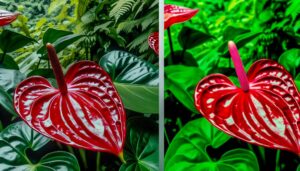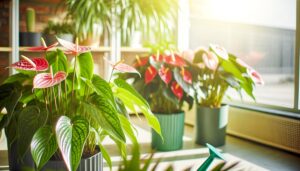A Step-by-Step Guide to Caring for Your Purple Anouk Anthurium
Caring for your Purple Anouk Anthurium involves several key steps. Position the plant in bright, indirect light, avoiding direct sunlight to prevent leaf scorching.
Water once the top inch of soil is dry, guaranteeing proper drainage to avert root rot. Use a well-draining potting mix comprising orchid bark, perlite, and peat moss.
Maintain temperatures between 65-80°F and humidity levels of 60-80%. Fertilize biweekly with a diluted balanced fertilizer and inspect regularly for pests.
Monitoring these factors will ensure prime growth and health for your Anthurium. For a more in-depth approach, consider further exploring each aspect.

Key Takeaways
- Place the Purple Anouk Anthurium in bright, indirect light to prevent leaf scorch.
- Water when the top inch of soil is dry, ensuring complete drainage.
- Use a well-draining potting mix of equal parts orchid bark, perlite, and peat moss.
- Maintain a temperature range of 65-80°F with 60-80% humidity for optimal growth.
- Fertilize biweekly with a balanced 20-20-20 N-P-K fertilizer, diluted to half-strength.
Ideal Lighting Conditions
Securing ideal lighting conditions is crucial for the healthy growth and vibrant coloration of the Purple Anouk Anthurium. This tropical plant thrives in bright, indirect light, mimicking its natural rainforest habitat. Direct sunlight can scorch the leaves, leading to discoloration and damage.
Position the Anthurium near an east or north-facing window where it can receive filtered sunlight. If natural light is insufficient, utilize fluorescent or LED grow lights, maintaining a distance of 12-18 inches from the plant to avoid overheating. A light intensity of approximately 10,000 to 20,000 lux is optimal.
Monitor the plant for signs of inadequate lighting, such as yellowing leaves or leggy growth, and adjust the light source accordingly to ensure prime photosynthetic activity.
Watering Techniques
Proper watering techniques are vital for the Purple Anouk Anthurium, as both overwatering and underwatering can lead to root rot or dehydration, respectively. To achieve ideal hydration, water the plant thoroughly when the top inch of soil feels dry to the touch. This guarantees moisture reaches the root zone without causing waterlogging. Employ a watering can with a narrow spout to direct water precisely at the base, avoiding foliage that can promote fungal growth.
Additionally, make sure that excess water drains completely, as stagnant water can suffocate roots. Monitoring humidity is also crucial; maintaining 60-80% relative humidity mimics the plant's native tropical environment, supporting its water needs. Regularly check moisture levels to adjust watering frequency accordingly.
Soil and Potting Mix
Selecting the appropriate soil and potting blend is crucial for the optimal growth of the Purple Anouk Anthurium, as it requires a well-draining medium abundant in organic material to flourish.
A suggested blend consists of equal portions orchid bark, perlite, and peat moss. This combination guarantees proper aeration and moisture retention, averting root decay. The orchid bark offers structural support and drainage, while perlite improves aeration. Peat moss retains moisture and provides organic nutrients.
Incorporating activated charcoal can additionally boost drainage and deter fungal growth. It is vital to utilize a container with drainage apertures to facilitate excess water drainage.
Transplanting every two years in new soil will maintain nutrient levels and root vitality, encouraging robust growth.
Temperature and Humidity
Maintaining an ideal temperature range of 65-80°F (18-27°C) and ensuring high humidity levels of around 60-80% is essential for the health and vigor of the Purple Anouk Anthurium. These conditions mimic the plant's native tropical environment, promoting optimal growth and vibrant blooms. Consistent temperature and humidity are crucial, as fluctuations can stress the plant, resulting in stunted growth or leaf damage. To achieve this, consider using a humidifier or placing the plant on a humidity tray. Avoid placing the Anthurium near drafts or air vents to prevent rapid changes in temperature and humidity.
| Condition | Ideal Range |
|---|---|
| Temperature | 65-80°F (18-27°C) |
| Humidity | 60-80% |
| Daytime Temp. | 70-80°F (21-27°C) |
| Nighttime Temp. | 65-70°F (18-21°C) |
| Humidity Boost | Humidifier/Tray |
Fertilizing Your Plant
Balancing the Purple Anouk Anthurium's nutrition with a well-rounded, nutrient-rich fertilizer is crucial for maintaining its lush leaves and vibrant blossoms. Use a water-soluble fertilizer with a balanced N-P-K ratio, like 20-20-20, diluted to half-strength to prevent root burn.
Apply the fertilizer biweekly during the active growing season from spring to early autumn, tapering off in winter when the plant's growth slows. To promote ideal nutrient uptake, ensure the soil is consistently moist but not waterlogged before application.
Furthermore, supplement with a micronutrient-rich fertilizer every two months to provide necessary trace elements such as magnesium and iron. Regularly monitor the plant's response to fertilization, adjusting frequency and concentration as necessary to support strong growth and flowering.
Pest and Disease Control
To sustain the health and strength of your Purple Anouk Anthurium, it is important to remain vigilant against common pests and diseases that can compromise its well-being. Regularly inspect the foliage and stems for signs of infestation or infection. Common pests include aphids, spider mites, and mealybugs, while bacterial blight and root rot are frequent diseases. Utilize insecticidal soap for pests and maintain proper watering techniques to prevent disease. Below is a table to guide your pest and disease control efforts:
| Pest/Disease | Symptoms | Treatment |
|---|---|---|
| Aphids | Yellowing leaves | Insecticidal soap |
| Bacterial Blight | Water-soaked lesions | Remove affected parts |
| Root Rot | Wilting, discolored roots | Improve drainage, reduce water |
Conclusion
To sum up, the best care of the purple anouk anthurium involves adhering to precise lighting conditions, employing meticulous watering techniques, utilizing a well-draining soil and potting mix, maintaining appropriate temperature and humidity levels, and implementing a judicious fertilization regimen.
Vigilant monitoring for pests and diseases is also crucial. By following these guidelines, the plant's health and aesthetic appeal can be sustained, thereby ensuring its longevity and the continued admiration of its striking beauty.






